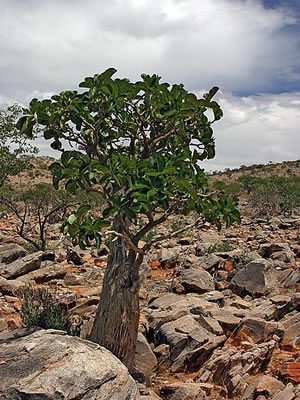The Bushman’s Poison (Adenium boehmianum), also known as desert rose and impala lily, is a peculiar deciduous species, with pink flowers and very broad leaves. It exhibits long periods of dormancy and less exuberant flowering than its cousin, Adenium obesum. Adenium boehmianum appears to be related to A. swazicum, but occurs on the other side of southern Africa, in rocky and dry locations in northern Namibia, southern Angola, and Botswana, at altitudes of 900-1,200 meters (2,953-3,937 feet).

It is an erect, slow-growing shrub, reaching a height of 1.5 meters (about 5 feet). It has a caudex and succulent roots, though not as prominent as in other Adenium species. The branches are grey to whitish, covered with dark spots from old leaf bases. The leaves emerge at the branch tips and last only three months per year. They are the largest in the entire genus, measuring 8 to 14 centimeters (3-5.5 inches) in length and 5 to 8 centimeters (2-3 inches) in width. They have a leathery texture, are shiny, paler on the underside, and fold along the central vein.
The flowers are almost circular, trumpet-shaped, and appear at the end of summer, autumn, and early winter. This species shares with A. swazicum uniform pink to red petals that do not fade towards the dark center, and features very short anther appendages, as well as being hairy externally. A. boehmianum is not very popular in cultivation.
The sap of A. boehmianum is very bitter and is the only species used by the Heikom nomads of Namibia to poison their hunting arrows. The poison is extracted in winter after the plants have flowered. The caudex is unearthed, and the sap extracted by pressing or heating the thicker branches and roots over a fire until the sap exudes. It is boiled down to condense into a thick, light brown syrup, cooled, and applied to the arrow tip. This potent poison can kill large antelopes, which fall within 100 meters (328 feet) of being hit. Gazelles die in less than an hour. Sometimes sap from various Euphorbiaceae species is added to make the poison even more potent. The word ouzuwo is the Herero word for poison.
The Bushman’s Poison should be grown in full sun or partial shade, in well-drained, neutral, sandy soil, enriched with organic matter, and watered at sparse and regular intervals. It does not tolerate waterlogging. Despite these drainage requirements, it is not advisable to leave it without watering for too long. Although it tolerates partial shade, abundant flowering is only achieved in full sun. Pruning should be done with gloves, as its sap is highly toxic. It is propagated by seeds and cuttings.

